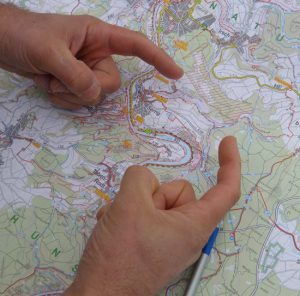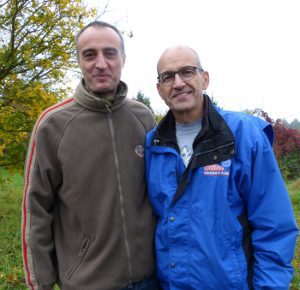
We got up to the historic site early that morning. And the sun was out. There was a clear sky up where we were on the hilltop overlooking the Saar River, in Germany. But the air below us, immediately above the river itself, was so clogged with fog we couldn’t see the spot where the historic river crossing had happened. I wondered out loud what it looked like beneath the fog.
“Here. I’ll show you,” said a man who’d stopped by to watch us look into the valley. And he pulled out a map of the river valley and he pointed. “The Americans came from the far side, crossed the river, and attacked up these slopes.”
As I’ve explained the past couple of columns, I recently travelled across the ground where my father served as a medical corpsman in the U.S. Army during the Second World War. He had been part of George S. Patton’s Third Army chipping away at the Nazi occupation of Europe in the winter of 1945. And I – never having retraced his wartime steps before – was covering the same ground 72 years later.

“It was the crossing of the Saar River,” the man with the map continued. “It was pretty important.”
I asked him to show me where the U.S. troop movement had occurred. He put his hands down on the map and showed me a pincer movement. The man with the map wasn’t with our tour. His name was Giuseppe Castronovo, and he had taken a half day off work just to catch up with us and meet us. He later explained why a man of Italian descent growing up in Germany felt so strongly about meeting our group, members of the 94th Infantry Division Historical Society.

“I have grown up in this part of Germany,” he said. “I’ve been interested in military history all my life, but this is special, because it happened here at my front door.”
In the last eight weeks of the war, U.S. troops, including the 94th, broke through the German armament line known as the Saar-Moselle Triangle, that the Germans considered impregnable. Back then, Hitler’s military engineers had designed and constructed among the strongest and most intricate defensive structures ever known.
Bunkers, pillboxes, trenches, land mines, booby-traps and concrete defensive lines, known as dragons’ teeth, criss-crossed the landscape. But U.S. troops, my father – Alex Barris – included, broke through it, and marched eventually to Trier and by May 8, 1945, had helped bring the war in Europe to an end.
As an adult, Castronovo clearly wanted to know more than just the physical aftermath of the war. So, he began to read, collect stories and ask questions of his elders. When he did he learned that the war had indeed come to right his front doorstep. His neighbour in Saarburg said that a German tank crew had even hidden a tank between the house where he now lived and the one next door.

Not long after I met the man with the map, our tour made its way to another important flashpoint in the liberation of Germany, at a village called Sinz. One of the 94th Infantry Division veterans with us on the tour, Herb Ridyard, in his nineties, led us to wooded area where he’d dug a foxhole in freezing March weather that winter to hunker down in the fighting.
“To call my spot a foxhole is a misnomer,” Ridyard said. “It was two holes big enough for two men with freezing water in it. … [Later] when the doctor examined my feet, they took me to a hospital because my feet were frozen.”
When Ridyard had finished his story, a woman who’d also joined our tour to pay her respects to the veterans and travellers mostly from the United States, stepped forward.

We learned it was Helen Patton, the granddaughter of George Patton, the general who’d commanded the regiments in which Herb Ridyard and my father had served. She had come all the way from Bastogne, Belgium, to recognize Herb Ridyard’s service.
“It’s my honour,” she announced to the assembled group in the woods, “to award you with a medal specially struck in commemoration of Gen. Patton, my grandfather.”
I came away from these few days of exploring war history in Germany, enlightened and encouraged that even after nearly three-quarters of a century the children and the grandchildren of the soldiers and the liberated had not forgotten. The next day, as we were leaving for the airport, a man ran up to me and handed me an envelope. It was Giuseppe Castronovo. He had again taken time off work to see us off. I later opened the package. It contained the map he used to show me the troop movements crossing the Saar in 1945.
“It is the battlefield your father survived,” Castronovo wrote in a note with the map. “For me it is now the ground [where] my wife and I raise our children. [The vets] made it worth living in again.”
Thank you for this wonderful account of your experience